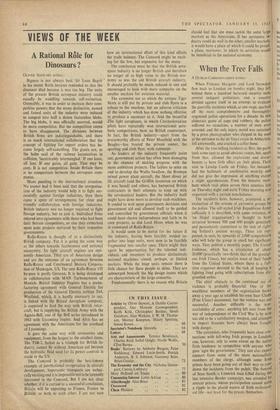VIEWS OF THE WEEK
A Rational ROle for Dinosaurs ?
OLIVER STEWART writes :
Bigness is not always best. Sir Leon Bagrit in his recent Reith lectures reminded us that the dinosaur died because it was too big. The units of the present British aerospace industry could equally be waddling towards self-extinction. Ostensibly, it was in order to increase their com- petitive powers that the many distinctive, named and famed units of the industry were induced to congeal into half a dozen featureless blobs.
. The big blobs, it was officially asserted, would be more competitive. But the competition seems
to have disappeared. The 'divisions between British firms are indistinguishable, and there is so much international collaboration that the concept of fighting for export orders has be- come largely self-cancelling. The giants are, as the babu said of the railway locomotives in collision, 'inextricably intermingled.' If one loses, all lose. If one gains, all gain. That may be cosy. It is not competitive. Inside Britain there is no competition between the aerospace com- panies.
More puzzling is the international situation. No sooner had it been said that the reorganisa- tion of the industry would help it to fight suc- cessfully against foreign industries, than there came a spate of arrangements for close and friendly collaboration with foreign industries.
British industry was no longer required to fight fbreign industry, but to join it. Individual firms
entered into agreements with those who had been their fiercest competitors, or else they embarked upon joint projects nurtured by their respective governments'
Rolls-Royce is thought of as a distinctively British company. Yet it is going the same way as the others towards facelessness and national anonymity. Its light aircraft engines are emi- nently American. They are of American design and are the outcome of an agreement between Rolls-Royce and Continental Motors Corpora- tion of Muskegon, US. The new Rolls-Royce 153 by-pass is partly German. It is•being developed in collaboration with MAN TurbomOtOren of Munich. Bristol Siddeley Engines has a manu- facturing agreement with General Electric for production of the General Electric turbine T64. Westland, which, it is hardly necessary to say, is linked with the Bristol Aeroplane company, is supposed to lead the way with British rotor- craft, but is supplying the British Army with the
Agusta-Bell, one of the Bell series introduced in 1963 with Lycoming engine. And Alvis has an agreement with the Americans for the overhaul of Lycomings.
It goes the same way with accessories and equipment, from the largest to the smallest items. The TSR-2, hailed as a triumph for British in- dustry, cannot fly without American aid because the hydraulic fluid used for its power controls is made in the US.
The, Concord is probably the best-known example of international co-operation in aircraft
development. Supersonic transports are techni-
cally exciting and it is impossible not to be intensely interested in the Concord. But I am not clear
whether, if it is carried to a successful conclusion, Britain will be exporting to France, France to Britain, or both to each other. I am not sure bow an international effort of this kind affects the trade balance. The Concord might be excit- ing for the few, but expensive for the many. The conclusion must be that the British aero- space industry is no longer British and therefore no longer of as high value to the British eco- ' nomy as was the old British aircraft industry. It should probably be much reduced in size and encouraged to look with more sympathy on the smaller markets for aviation material.
The extensive use to which the antique Tiger Moth is still put by private and club flyers is a tribute to the machine, but an adverse criticism of the industry which has done nothing effective to produce a successor to it. And the beautiful Zlin light aeroplanes, in which Czechoslovakian pilots have repeatedly won international aero- batic competitions, have no British counterpart. In fact, the British industry—apart from the praiseworthy efforts of Peter Masefield with the Beagles—has treated the private owner, the sporting and club flyer, with contempt.
As leaders of the industry frequently point out, government action has often been damaging to the chances of making progress with the more ambitious projects. The failure to seize on and to develop the Wallis Swallow, the Brennan mixed power plant aircraft, the Short direct jet lift aircraft (and the Griffith invention on which it was based) and others, has hampered British contractors in their attempts to keep up with the aeronautical leaders. But the industry itself might have done more to develop such machines. It tended to wait upon government decisions and government aid and allowed itself to be guided and controlled by government officials when it could have shown independence and faith in its own projects, as did Lord Hives when he was in command of Rolls-Royce. • It would seem to be useful •for the future if the industry, having been forcibly welded to- gether into huge units, were now to be forcibly fragmented into smaller ones. There might then again be opportunities for the talented indi- viduals and inventors to produce distinctively national machines aimed, perhaps, at limited markets. While the huge units remain there is little chance for these people to shine. They are submerged beneath the big design teams which are characteristic of the large consortia.
Fundamentally there is no reason why Britain
should feel that she must tackle the same large markets as the Americans. If her aerospace in- dustry could do well in the other, smaller marketi, it would have a place of which it could be proud; a place, moreover, in which its activities would be beneficial to the national economy.






























 Previous page
Previous page